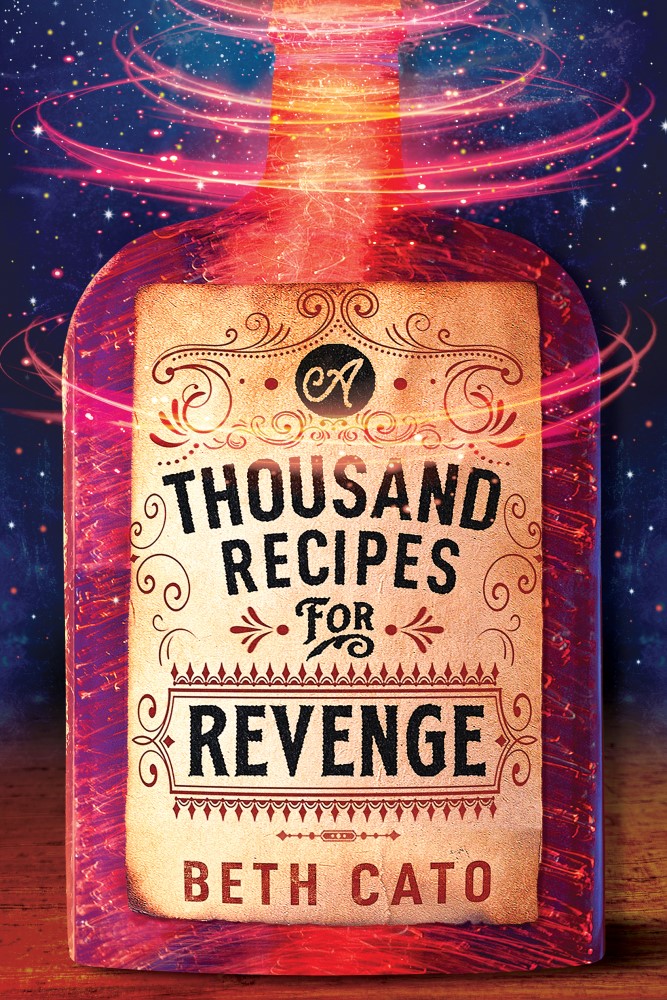
Beth Cato is joining us today to talk about her novel, A Thousand Recipes for Revenge. Here’s the publisher’s description:
A world on the brink of war and a mother and daughter on the run, in a thrilling novel of swashbuckling adventure, culinary magic, and just desserts.
Adamantine “Ada” Garland has an empathic connection to food and wine, a magical perception of aromas, flavors, and ingredients. Invaluable property of the royal court, Ada was in service to the Five Gods and to the Gods-ordained rulers of Verdania—until she had enough of injustice and bloodshed and deserted, seeking to chart her own destiny. When mysterious assassins ferret her out after sixteen years in hiding, Ada, now a rogue Chef, and her beloved Grand-mère run for their lives, only to find themselves on a path toward an unexpected ally.
A foreign princess in a strange court, Solenn unknowingly shares more with Ada than an epicurean gift. They share blood. With her newfound magical perception, she becomes aware of a plot to kill her fiancé, the prince. It’s part of a ploy by adversarial forces in the rival country of Albion to sow conflict, and Solenn is set up to take the blame.
As Ada’s and Solenn’s paths converge, a mother and her long-lost daughter reunite toward a common goal, and against a shadowy enemy from Ada’s past who is out for revenge. But what sacrifices must be made? What hope is there when powerful Gods pick sides in a war simmering to eruption?
What’s Beth’s favorite bit?

Beth Cato
My new book, A Thousand Recipes for Revenge, uses a musketeer-era France-inspired setting as the backdrop for swashbuckling action and adventure, but it’s also about food. In this world, Chefs (that’s with a capital C) are holy personages touched by the Five Gods. They are cooks, priests, wizards, and soldiers, all rolled into one. They are able to tap the potential of special ingredients, called epicurea; when people eat this food, they experience magical effects ranging from physical regeneration to stone-like skin for a battle to slow, terrible deaths by incurable poisons. Rare Chefs like my character Ada are gifted/cursed with what’s called an empathetic tongue: she can taste foods that other people are carrying, and knows not only how it would taste in her own mouth but perceives how it would taste to the other person.
The ideas in the book were great fun to create; making it work in cohesive form was not. I labored through draft after draft of this novel. I lost enthusiasm and hope that I could make my complex plot work.
I had a friend–one of many–read through and critique the manuscript to add perspective. She loved the deep worldbuilding, but thought I could dig even deeper by using epigraphs. Those are sentences or paragraphs of related material that lead into chapters. I read her advice and felt like a cartoon-style lightbulb appeared over my head.
You see, I go all-in on research for my novels. I accumulate stacks of books, make lots of notes, and then usually only get to integrate a couple of facts to enrich the world. Using epigraphs would give me a chance to have even more fun with my subject matter, adding background without infodumps.
And it was fun, even though it created a lot of work. There are over forty chapters in A Thousand Recipes for Revenge. That meant a lot of epigraphs, and I wanted to take care that they were factual (magical and divine elements aside). That process, as tedious as it was, enabled me to rediscover the joy of the book and the result became one of my favorite aspects of the whole thing. In the end, they also helped to sell the book–and a sequel–to 47North.
Here are some my favorite epigraphs, many of which quote made-up reference materials or connect foods with the Five Gods that oversee cuisine. (Gyst is the God of Unknowns such as mold and fermentation.) Since many cheeses we know on Earth are named after places of origin, I added slight twists to names so that they are both recognizable and unique.
Commoners believe that a Chef is best identified by their distinct uniform dress, but in all truth, the best way to recognize one is by how they dress a chicken.
—Excerpt from Manual for Tour Chefs
The shelf must be cool and dark, the air moist. The cheese must have space around it and be turned once each day upon its mat. If the conditions are right, Gyst’s presence will soon be known. A smell of yeast and fruit should be present within three to four days. Then, over the next five, the surface of the cheese will dry and be kissed by white mold. If it grows especially thick, turn the cheese twice or thrice daily. Show thanks to Gyst by whispering to him your choicest secrets.
—Excerpt from a recipe for abree cheese
One may assume that a Chef or cook specializing in butchery must be strong to lift meat and hew bone, but consider also the experts in patisserie who whisk egg whites for prolonged periods to develop the stiff peaks required for light cakes or refreshing syllabubs. These artists boast of upper arms like those of a pugilist!
—Excerpt from Book for Cooks to Excel as Do Chefs
If you want to immerse yourself in more historical food fact geekery plus action-packed daring-do, A Thousand Recipes for Revenge is out today!
LINKS:
A Thousand Recipes for Revenge universal book link
BIO:
Nebula Award-nominated Beth Cato is the author of A Thousand Recipes for Revenge from 47North plus two fantasy series from Harper Voyager. She’s a Hanford, California native who now wanders in distant realms with feline companions in close orbit. Follow her at BethCato.com and on Twitter at @BethCato.
